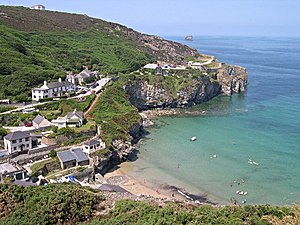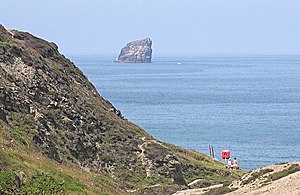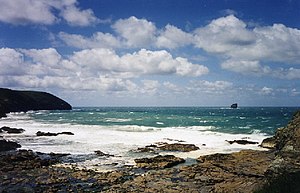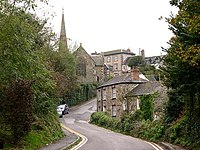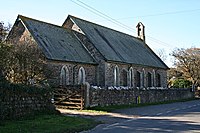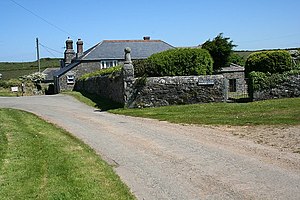Difference between revisions of "St Agnes, Cornwall"
(Created page with ':''Not to be confused with St Agnes, Isles of Scilly, an island also in Cornwall'' {{Infobox town |name=St Agnes |cornish=Breanek |county=Cornwall |picture=Churchtown, St Agn…') |
|||
| Line 1: | Line 1: | ||
| − | + | {{Hatnote|Not to be confused with [[St Agnes, Isles of Scilly]], an island also in Cornwall}} | |
{{Infobox town | {{Infobox town | ||
|name=St Agnes | |name=St Agnes | ||
Latest revision as of 17:32, 7 August 2014
| St Agnes Cornish: Breanek | |
| Cornwall | |
|---|---|
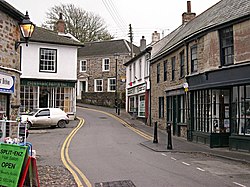 Churchtown, St Agnes | |
| Location | |
| Grid reference: | SW713507 |
| Location: | 50°18’44"N, 5°11’57"W |
| Data | |
| Population: | 2,230 |
| Post town: | St. Agnes |
| Postcode: | TR5 |
| Dialling code: | 01872 55 |
| Local Government | |
| Council: | Cornwall |
| Parliamentary constituency: |
Truro and Falmouth |
St Agnes is a large village on the north coast of Cornwall, about five miles north of Redruth and ten miles southwest of Newquay. It is a popular holiday village but has a grittier past in tin mining going back to prehistory, the signs of which are all over the village and the cliffs.
The village of St Agnes, a popular coastal tourist spot, lies on a main road between Redruth and Perranporth. It was a prehistoric and modern centre for mining of copper, tin and arsenic until the 1920s. Local industry has also included farming and fishing, and more recently tourism.
The St Agnes district has a heritage of industrial archaeology and much of the landscape is of considerable geological interest. There are also stone-age remains in the parish.
The manor of Tywarnhaile was one of the 17 Antiqua maneria of the Duchy of Cornwall.
Contents
Name
The original name of St Agnes was "Bryanick", a Cornish name which may mean pointed hill, presumably St Agnes Beacon.[1] Craig Weatherhill though suggests it was a compound of brea (hill) and Anek (Agnes) and gives the first recorded form as "Breanek" (1420–99).[2]
Neither Bryanick nor St Agnes, though, were established at the time of the Domesday Book of 1086 and the area was included in Perran Sand (Perranzabuloe).
The St Agnes Chapel was named after the Roman martyr St Agnes of Rome who was killed for refusing to marry a son of Sempronius, a governor of Rome in 304 AD.
According to Arthur G. Langdon, writing in the 1890s, the inhabitants of St Agnes pronounced its name as if it were "St Anne's" to distinguish it from St Agnes in the Isles of Scilly.[3]
Geography
St Agnes is on Cornwall's north coast in the Pydarshire hundred. Its coastline is known as the "St Agnes Heritage Coast",[1] which has been a nationally designated protected area since 1986.
The marine site protects 40 species of mammals and amphibians.[4][5] Interesting features along the coast include Trevaunance Cove, Trevellas Porth, Crams, Chapel Porth, Hanover Cove, and Porthtowan. Some of these have beaches, and there are also two beaches at Perranporth.[6]
The 1,549-acre Godrevy Head to St Agnes site,[7] is situated along the north Cornwall coast of the Atlantic Ocean. It starts at Godrevy Head (with the Godrevy Towans) in the west and continues for 12 miles to the northeast, through Portreath, Porthtowan and ends just past St Agnes Head, north of the village of St Agnes.
Churches
The parish church is the Church of St Agnes is believed to have been built as a chapel of ease about 1482, on the foundation of what is possibly an ancient Celtic church (410 to 1066 AD). The records of the Diocese of Exeter refer to a chapel of St Agnes in the parish of Perranzabuloe in 1374. In mediæval and early modern times St Agnes was part of the parish of Perranzabuloe, but in 1846 it was made into a parish and the chapel its parish church. Two years later the building itself was restored by Piers St Aubyn. In 1905 the spire was rebuilt. It is a Grade II listed building.[8]
On the southwest side of the church by the churchyard gate is a granite wayside cross from the Middle Ages. The stone is the remains of a lych stone used for holding coffins.[9] Arthur G. Langdon notes that John Thomas Blight recorded its former use as a lych stone.
In 1846 the Mount Hawke chapel-of-ease, dedicated to St John the Baptist, was formed from church members who had been meeting in a small building in the village; it became the parish church of the new ecclesiastical parish of Mount Hawke in 1847.
Another Anglican chapel-of-ease was St Peter's Church in Mithian.
Churches in and around St Agnes include:
- Church of England:
- St Agnes
- Mount Hake Parish Church
- Methodist: several churches -
- Roman Catholic: Our Lady, Star of the Sea (1882)
History and antiquities
Antiquities
There are a number of ancient archaeological sites in the St Agnes parish.[10] The earliest found to date are mesolithic fragments which are dated from 10,000 to 4,000 BC. They were found near New Downs and West Polberro.[11]
During the Bronze Age, barrows were created in many places in the area,[12][13][14]
The Trevellas Barrow site lies at the end of one of the Trevellas Airfield runways. Excavated in 1940 by Charles Kenneth Croft Andrew, the site is believed to be a tumulus or burial site that had a bucket urn and pottery sherds. It was defined as an "intact ritual deposit", probably from about 2000 BC. There are no sign of its former shape.[15] A larger barrow site east of St Agnes village shows evidence of cremation and up to eight barrows.[16]
St Agnes Beacon is the site of several barrows or cairns from this age. It was later a beacon point at some time between 1580 and 1732 and a prospect tower between 1767 and 1799.[17]
There were other Bronze Age barrows in the area.[18]
During the Iron Age there were more forts and there is evidence of mining.[19]
Just south of Mount Hawke was an Iron Age round enclosure. There may have also have been mining or quarry activity on this site during the Middle Ages.[20] Northwest of Wheal Rose was an Iron Age building, a terraced field system, and an excavation pit.[21]
On the coast, west of St Agnes Beacon, is a piece of land called Tubby's Head. It was an Iron Age (800 BC to 43 AD) promontory fort or quay. A causeway entrance exists to the north side of the site.[22] A noteworthy Iron Age site is the Caer Dane hillfort 2 miles southeast of Perranporth. It had three concentric defensive walls surrounding the inner, topmost ring.[23] St Piran's enclosed round was 656 feet wide and may have been a "playing place" (performance area). During the Middle Ages it was converted to a "Plain-an-gwarry (theatre)". It is still used sometimes as a theatre.[24]
There are other prehistoric geographic features, but the specific age or time period is unclear.
South of Mount Hawke was a late prehistoric settlement of unenclosed huts.[25] Nearby, close to the houses at Menagissey, are two late prehistoric or Roman rounds with a circular enclosure.
Middle Ages
The first chapel or church in St Agnes was believed to have been build as an early Celtic church some time between 410 and 1066 AD; At that time it also had an enclosure. The Church of St Agnes was built on the same location around 1482. A mediæval chapel with an enclosure stood at Chapel Porth. There was a holy well and a post-mediæval (1540 to 1901) storehouse or shelter on the site. The chapel was destroyed in 1780, and the well remained until 1820. There are still some remains ruins of the mediæval enclosure and the small building.[26]
During the Middle Ages there was tin working at St Agnes Head with an extractive pit for openworks and lode back workings. There are also ancient signs of tin works at Wheal Coates, near the Chapel Porth area cliffs. The site includes an adit, which is a tunnel or access to the mine; dam; dressing floor where the ore was processed for smelting; and an open cut where excavation occurred in a ravine on the surface.
A manor was built in St Agnes during the Middle Ages. Between 1700 and 1800 a house was built on the site of the previous manor.
16th and 17th century
A chapel created between 1540 and the 1800s was located just north of Mawla. In its latter years the building was a shed for cows. By 1847 it was in ruins. The St John the Baptist church in Mount Hawke received the font from this church, although its original "Mediæval" carvings were lost when the font was resculpted.[27]
The area saw an emergence of a variety of industries, such as pubs. The Miners Arms Public House was constructed in Mithian in the 17th century. It saw additions and renovations in the following two centuries. The building exterior is made of granite, killas rubble, brick and elvan. It is roofed in Delabole slate.[28] Trevaunance Cove had a post mediæval lime kiln that operated sometime between 1540 and 1901.[29]
18th and 19th century
Mediæval mining locations began to take on modern methods of mining in the 19th century, like that at Wheal Coates.[26] Wheal Lushington is thought to have been the biggest tin mining operation in the area. Operational by 1808, smelting was also performed at Wheal Lushington.[30] Modern mining practices were employed at Blue Hills Mine about 1810 and until 1897. There had been prior mining activities in that area before 1780.[31] A number of copper, tin and arsenic mines operated during the 18th, 19th and some into the 20th century.
Allen's Corn Mill operated at Porthtowan between 1752 and 1816.[32]
20th century
From 1903 until 1963 a railway station on the Perranporth line operated in St Agnes. After the railway station closed, the dismantled railway was used for the mining industry.
Between 1939 and 1940, Cameron Camp, also known as the 10th Light Anti-Aircraft Practice Camp, Royal Artillery, was built on the site of a Napoleonic Wars target. The camp was named after an area landowner and served as an army camp, slit trench and anti-aircraft battery. After the war the camp was used for housing. It was levelled in 1971.
Leisure
Outdoor activities include beach side walks, swimming, and surfing. The area has a number of paths for coastal walks or cycling. There are also art shows, craft fayres, tea parties and coffee mornings. Music and dancing can be found in the public houses. Annual events are Carnival week, Lifeboat day, Summer plays by the St Agnes Players, Victorian Fair Day and the Bolster the Giant pageant.[33][34]
The Blue Hills area hosts the Motor Cycling Club's Lands End Trial for cars and bikes. The first run being held in 1908.[35] There are several sports clubs including rugby union, football, boxing and netball.[36]
The St Agnes Parish Museum provides information about the history of the St Agnes area. Mining and the coastal history figure prominently, including a 700 lb leatherback turtle.[37]
Harbour
Since the 17th century there have been many attempts to create a harbour for St Agnes. Between 1632 and 1709 the Tonkins, lords of the manor of Trevaunance, expended the family legacy as they tried to build a harbour. Three attempts were made, the last of which was assisted by Henry Winstanley, but that harbour was washed away in 1705.[38] The harbour built in 1710 by an unrelated party was levelled in 1730 by the crashing Atlantic Ocean waves. A new harbour constructed in 1798 supported a fishing industry and allowed for the export of copper ore and the import of coal from South Wales for the smelters at the mines. St Agnes remained a busy port until the collapse of the harbour wall in a storm in 1915/16. There are only remains of the old harbour in existence.[39][40][41]
In 1802, a pilchard fishing industry was established from the harbour, reaching its peak in 1829 and 1830 before declining.[39]
Outside links
| ("Wikimedia Commons" has material about St Agnes, Cornwall) |
References
- ↑ 1.0 1.1 St Agnes Heritage Coast. British Express. Retrieved 18 September 2012.
- ↑ Weatherhill, Craig. (2009) A Concise Dictionary of Cornish Place-names, Westport, Co. Mayo: Evertype; p. 62
- ↑ Langdon, Arthur G. (1896) Old Cornish Crosses. Truro: Joseph Pollard, p. 77
- ↑ St Agnes Heritage Coast. Protected Planet. Retrieved 18 September 2012.
- ↑ Species Protected Planet: St Agnes Heritage Coast. Retrieved 18 September 2012.
- ↑ St Agnes Cornwall. Explore Britain. Retrieved 19 September 2012.
- ↑ "Godrevy Head to St Agnes". Natural England. 1989. http://www.sssi.naturalengland.org.uk/citation/citation_photo/1003195.pdf. Retrieved 6 December 2011.
- ↑ National Monuments Record: No. 428393 – Church of St Agnes
- ↑ National Monuments Record: No. 428373 – Wayside Cross at the Church of St Agnes
- ↑ Search on: St Agnes Cornwall. English Heritage National Monuments. Retrieved 21 September 2012.
- ↑ Monument No. 428381 - New Downs / West Polberro Monolith., Monument No. 428381 - New Downs / West Polberro Monolith - map. and Monument No. 428408 - New Downs / West Polberro Monolith. English Heritage National Monuments. Retrieved 21 September 2012.
- ↑ Search on: St Agnes Cornwall Barrow. English Heritage National Monuments. Retrieved 21 September 2012.
- ↑ National Monuments Record: No. 1151996 – Monument No. 1151996
- ↑ National Monuments Record: No. 68613 – Clearance Cairn
- ↑ National Monuments Record: No. 428340 – Trevellas Barrow
- ↑ National Monuments Record: No. 428346 – Monument No. 428346 - St Agnes Barrow
- ↑ National Monuments Record: No. 428343 – St Agnes Beacon Barrow, Beacon, and Tower
- ↑ National Monuments Record: No. 427900 – Middle Barrow, National Monuments Record: No. 427903 – Goonown Barrow, National Monuments Record: No. 427906 – Mingoose Barrow, National Monuments Record: No. 427915 – Mount Hawke Area Barrow, National Monuments Record: No. 427915 – Skinners Bottom Area Barrow, National Monuments Record: No. 427912 – Two Burrows Farm Area Barrow, National Monuments Record: No. 427942 – Mount Hawke and Two Burrows Farm Area Barrow
- ↑ National Monuments Record: No. 428361 – Agnes Beacon Iron Age Hillfort
- ↑ National Monuments Record: No. 427939 – Mount Hawke Area Iron Age round and enclosure
- ↑ National Monuments Record: No. 1137598 – Wheal Rose Area Iron Age building and terraced field
- ↑ National Monuments Record: No. 426274 – Promontory fort or landing point
- ↑ National Monuments Record: No. 428225 – Caer Dane
- ↑ National Monuments Record: No. 28200 – St Piran's Round
- ↑ National Monuments Record: No. 427930 – Mount Hawke Area Unenclosed Hut Settlement
- ↑ 26.0 26.1 National Monuments Record: No. 426049 – Mediæval Chapel
- ↑ National Monuments Record: No. 427954 – Mawla area chapel
- ↑ National Monuments Record: No. 1487398 – Miners Arms Public House
- ↑ National Monuments Record: No. 428402 – Lime Kiln
- ↑ National Monuments Record: No. 426073 – Wheal Lushington
- ↑ National Monuments Record: No. 428395 – Blue Hills Tin Mine
- ↑ National Monuments Record: No. 426067 – Allen's Mill
- ↑ Activities. St Agnes Chamber of Commerce. Retrieved 21 September 2012.
- ↑ Events. St Agnes Chamber of Commerce. Retrieved 21 September 2012.
- ↑ Landsend. The Motorcycling Club. Retrieved 22 September 2012.
- ↑ Sports Clubs. St Agnes Sports Club. Retrieved 22 September 2012.
- ↑ St Agnes museum
- ↑ Mee, Arthur (1937) Cornwall. (The King's England.) London: Hodder & Stoughton; pp. 195-96
- ↑ 39.0 39.1 Cornwall Industrial Settlements Initiative St Agnes. Cornwall Historic Environment Service. December 2002. Retrieved 30 April 2010.
- ↑ St Agnes - The Harbour. Cornwall Tourism Magazine. Retrieved 21 September 2012.
- ↑ Clegg, David (2005) Cornwall & the Isles of Scilly. Leicester: Matador; p. 89
- Foster, R. J. (1964) St Agnes Methodist Church
